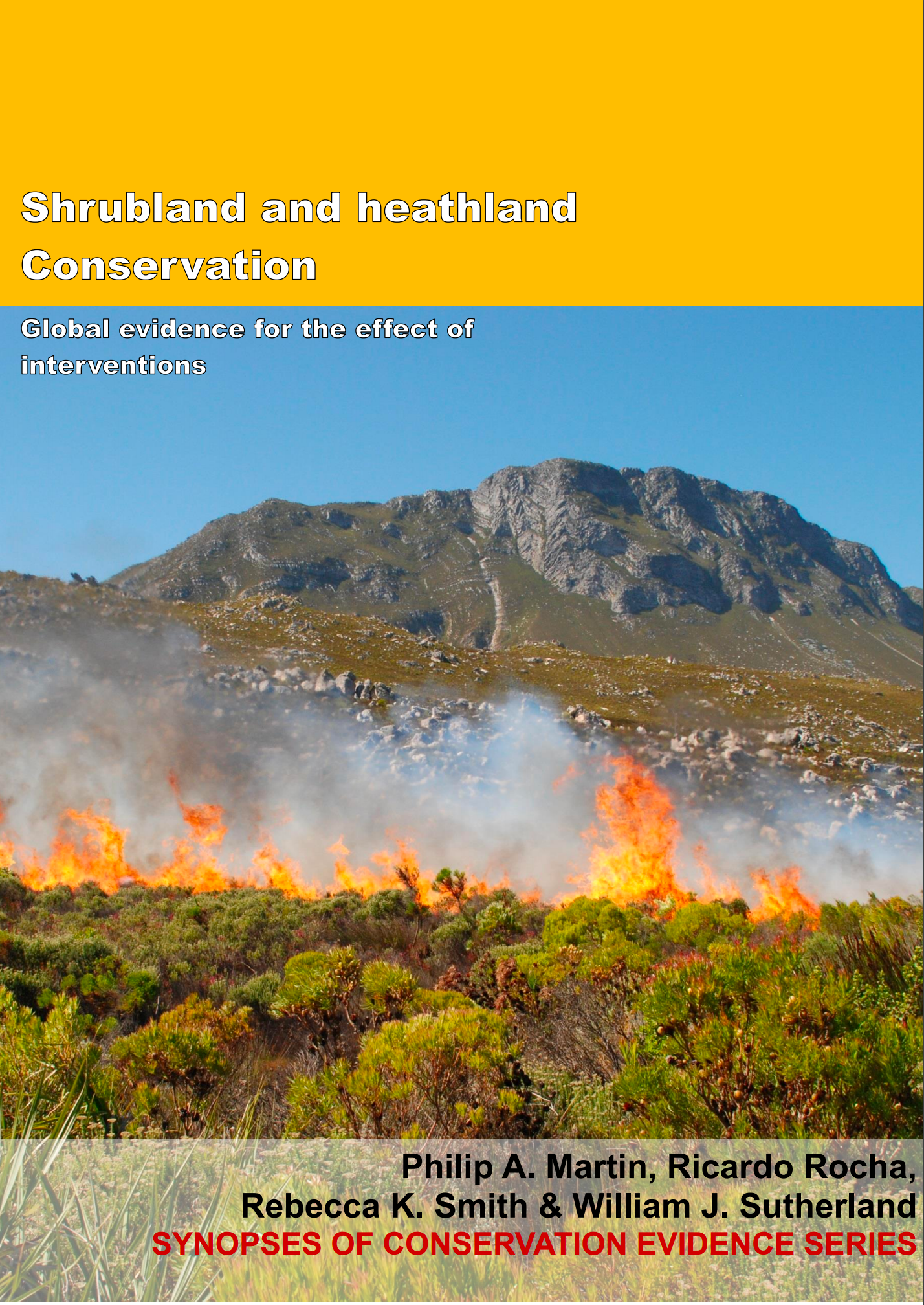Actions to conserve biodiversity
We have summarised evidence from the scientific literature about the effects of actions to conserve wildlife and ecosystems.
Review the evidence from the studies
Not sure what Actions are? Read a brief description.
Search for evidence
e.g. "frogs chytrid"
109 Actions found
Refine
Hide
109 Actions found
Download Actions
| 0 selected |
|
Order results by:
| Action | Effectiveness | Studies | Category | |
|---|---|---|---|---|
|
Legally protect plant species affected by gathering Action Link |
No evidence found (no assessment) | 0 |
|
|
|
Legally protect shrubland Action Link |
No evidence found (no assessment) | 0 |
|
|
|
Maintain habitat corridors in areas of energy production or mining Action Link |
No evidence found (no assessment) | 0 |
|
|
|
Maintain habitat corridors over or under roads and other transportation corridors Action Link |
No evidence found (no assessment) | 0 |
|
|
|
Maintain/create habitat corridors in developed areas Action Link |
No evidence found (no assessment) | 0 |
|
|
|
Mow shrubland to reduce impacts of pollutants Action Link |
Unknown effectiveness (limited evidence) | 2 |
|
|
|
Place signs to deter gathering of shrubland species Action Link |
No evidence found (no assessment) | 0 |
|
|
|
Plant individual plants Action Link |
Unknown effectiveness (limited evidence) | 3 |
|
|
|
Plant seed balls Action Link |
Unknown effectiveness (limited evidence) | 1 |
|
|
|
Plant shrubs in clusters Action Link |
Unknown effectiveness (limited evidence) | 1 |
|
|
|
Plant spiny shrubs to act as barriers to people Action Link |
No evidence found (no assessment) | 0 |
|
|
|
Plant turf Action Link |
Unknown effectiveness (limited evidence) | 3 |
|
|
|
Plant vegetation to act as a buffer to exclude pollution Action Link |
No evidence found (no assessment) | 0 |
|
|
|
Plant/seed under established vegetation Action Link |
Unknown effectiveness (limited evidence) | 1 |
|
|
|
Plant/sow seeds of nurse plants alongside focal plants Action Link |
Unknown effectiveness (limited evidence) | 2 |
|
|
|
Provide education programmes about shrublands Action Link |
No evidence found (no assessment) | 0 |
|
|
|
Raise awareness amongst the general public Action Link |
No evidence found (no assessment) | 0 |
|
|
|
Rake to control grass Action Link |
Unknown effectiveness (limited evidence) | 1 |
|
|
|
Re-route paths to reduce habitat disturbance Action Link |
Unknown effectiveness (limited evidence) | 1 |
|
|
|
Reduce fertilizer use on nearby agricultural/forestry land Action Link |
No evidence found (no assessment) | 0 |
|
|
|
Reduce herbicide use on nearby agricultural/forestry land Action Link |
No evidence found (no assessment) | 0 |
|
|
|
Reduce number of livestock Action Link |
Beneficial | 16 |
|
|
|
Reduce numbers of large herbivores Action Link |
Unknown effectiveness (limited evidence) | 2 |
|
|
|
Reduce pesticide use on nearby agricultural/forestry land Action Link |
No evidence found (no assessment) | 0 |
|
|
|
Reduce the frequency of prescribed burning Action Link |
No evidence found (no assessment) | 0 |
|
Download Actions
| 0 selected |
|

Shrubland and Heathland Conservation - Published 2017
Shrubland and Heathland synopsis
Watch this search
If you are familiar with RSS feeds, please click the button below to retrieve the feed URL:
RSS feed for this searchIf you are unfamiliar with RSS feeds, we would suggest reading this BBC article.
Unfortunately, due to the number of feeds we have available, we cannot provide e-mail updates. However, you could use tools such as Feed My Inbox to do this for you.
What are 'Individual studies' and 'Actions'?
Individual studies
An individual study is a summary of a specific scientific study, usually taken from a scientific journal, but also from other resources such as reports. It tells you the background context, the action(s) taken and their consequences.
If you want more detail please look at the original reference.
Actions
Each action page focuses on a particular action you could take to benefit wildlife or ecosystems.
It contains brief (150-200 word) descriptions of relevant studies (context, action(s) taken and their consequences) and one or more key messages.
Key messages show the extent and main conclusions of the available evidence. Using links within key messages, you can look at the paragraphs describing each study to get more detail. Each paragraph allows you to assess the quality of the evidence and how relevant it is to your situation.
Where we found no evidence, we have been unable to assess whether or not an intervention is effective or has any harmful impacts.





)_2023.JPG)














